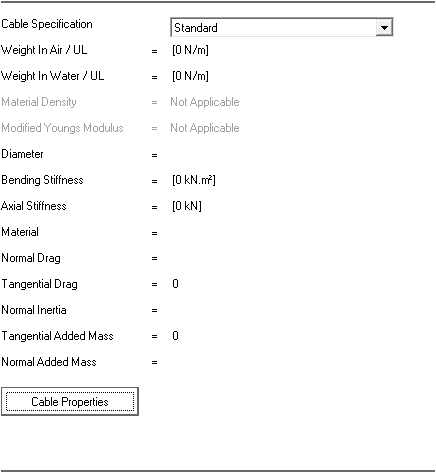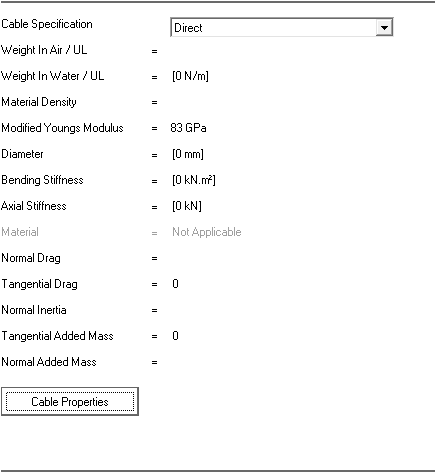The Cable component is used to specify the properties of an individual section of cable that has uniform properties. It is similar to the Pipe Section component in many respects, though less complex, as no additional coatings or attachments may be specified. The required inputs for the Cable component are illustrated in the figure below.

Cable Component
There are two methods of Cable Specification available, Standard and Direct.
Format Specification
With the Standard (default) method, the explicit specification of the following parameters – Weight in Air per Unit Length, Weight in Water per Unit Length, Bending Stiffness, Axial Stiffness – is optional, and default values are computed automatically from the properties of the selected Material component in conjunction with the input cable Diameter.
Computed default values are shown on the component view in square brackets to distinguish them from manual inputs. These default values can be overwritten if needs be with manual input, and if such input is specified for all parameters then the selection of a Material component is irrelevant. Note that the computation of default values for a Standard cable is based on the assumption of a solid cross section.
The Standard approach also requires the specification of hydrodynamic properties for the cable by defining values for Tangential Drag, Normal Inertia, Tangential Added Mass and Normal Added Mass. The properties can be specified through the Cable Properties dialog.

Cable Properties in Standard Format
Unlike the Standard method, the Direct specification does not allow for the selection of a Material and instead it consists of the following mandatory inputs - Weight in Air per Unit Length, Material Density, Modified Young’s Modulus (Defaults to 83 GPa metric or 12,000 ksi imperial).
In terms of stiffness values for the Direct approach, the Weight in Air per Unit Length and the Material Density are combined to determine an effective cross sectional area, which in turn is used in conjunction with the Modified Young’s Modulus to compute both a suitable default Bending and Axial Stiffness. The torsional stiffness is computed in a similar fashion however an assumed Poisson’s ratio of 0.3 is used in conjunction with the Modified Young’s Modulus to determine a suitable shear modulus. This torsional value cannot be overwritten by the user, unlike the Bending and Axial Stiffness.
The calculated default for the Weight in Water per Unit Length is also based on the Weight in Air per Unit Length and the effective cross sectional area.
The cable Diameter for the Direct specification is an optional input and is only used as the contact diameter for interaction with supports and the drag diameter for hydrodynamic loading. This means that the diameter from the effective cross sectional area is used in actual stress calculations. If omitted the cable diameter defaults to that of the effective cross sectional area.
The Direct approach also has the same set of hydrodynamic inputs as available in the case of the Standard method.
Finally, the various calculated default values for the Direct specification are displayed on the component view in a similar fashion to the Standard approach and can be overwritten if needs be. Note that these computed values are representative of a braided or stranded section and so should be more realistic than those from the Standard method. The properties can be specified through the Cable Properties Direct dialog.

Cable Properties in Direct Format
Additional articles provide information on the Cable Data Inputs and Cable Best Practice.